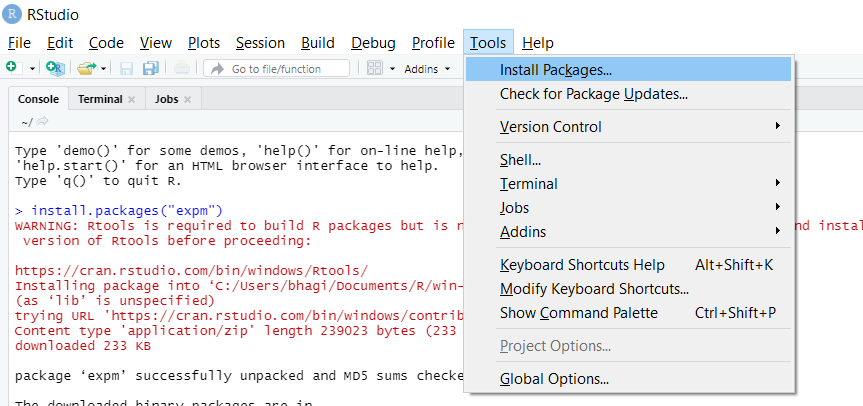在 R 中找到矩阵的幂
在本文中,我们将了解如何在 R 编程语言中计算矩阵的幂。矩阵是将数字排列成行和列。
在 R 编程中求矩阵幂的不同方法:
- 通过使用 %^%。
- 通过使用幂函数。
方法 1:通过使用 %^%
在使用它之前,我们需要将 expm 库导入我们的 R 工作室。
将 expm 库安装到 R studio 中:
步骤1:首先您需要选择工具。

步骤2:选择工具后,您需要按安装包:

下面是实现:
我们使用矩阵函数将 expm 和分配的值导入到 mat 中。之后,我们正在寻找矩阵的幂。
R
# loading expm library
library(expm)
# creating mat variable and storing
# matrix into it.
mat <- matrix(1:9, nrow=3)
# In matrix function data will fill column wise,
# here data will be 1 to 9 as we mentioned 1:9
# and rows will be 3 as we given nrows as 3
# finding power of matrix here power is 4
mat %^% 4R
# loading package
require(matrixcalc)
# creating matrix.
a<- matrix(1 : 9, nrow = 3)
# finding power of matrix by using power function.
# In matrix function data will fill column wise,
# here data will be 1 to 9 as we mentioned 1:9
# and rows will be 3 as we given nrows as 3
matrix.power(a, 9)输出:

方法 2:通过使用幂函数。
为了使用幂函数,我们需要将 matrixcalc 包安装到我们的 Rstudio 中
下面是实现:
这里我们使用矩阵函数将矩阵计算和赋值导入到 mat 中。之后,我们使用幂函数求矩阵的幂。
电阻
# loading package
require(matrixcalc)
# creating matrix.
a<- matrix(1 : 9, nrow = 3)
# finding power of matrix by using power function.
# In matrix function data will fill column wise,
# here data will be 1 to 9 as we mentioned 1:9
# and rows will be 3 as we given nrows as 3
matrix.power(a, 9)
输出:
